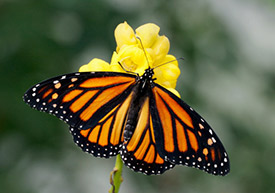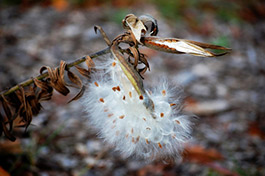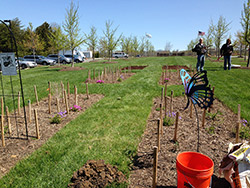During the past year, NRPA members have shown great interest in the national conservation efforts to save the monarch. This much-loved butterfly is a wildlife species in grave trouble. The Eastern population, which makes up the bulk of monarchs in the U.S., is most at risk. This population was estimated at over a billion individuals as recently as 20 years ago. Those numbers have plummeted almost 95 percent since then.

The causes of this population crash are many — loss of critical food plants (milkweeds), loss of habitat along the monarch’s migration routes, negative impacts to over-wintering areas in Mexico, extreme weather events during migration, and the yet to be fully known impacts from certain types of insecticides and herbicides.
But there is new hope for monarchs. Public opinion has been galvanized by the news of the potential disappearance of monarchs across North America, and support for saving the monarch has never been higher. National conservation organizations, corporations and the federal government have initiated new initiatives to reverse this decline. Some of these resources are becoming available, and your park and recreation agency might want to look for opportunities to utilize these resources to expand efforts in conservation, education and research.
NRPA believes that parks can make a true impact on the conservation of monarch butterflies. Park and recreation agencies have a unique ability and opportunity to educate the public and engage kids and citizen volunteers in a national conservation effort. They also have the power to measurably increase habitat that is vital for the return of the monarch by planting milkweed plants and seeds in suitable habitat areas. Look for NRPA CEO Barbara Tulipane’s call to action around “Parks for Monarchs” in the July issue of Parks & Recreation magazine. In the meantime, here are some new opportunities to find funding and resources for monarch conservation:
Free Milkweed Plants for Habitat Restoration
 Monarch Watch, the national education organization which coordinates a variety of monarch conservation activities, is making up to 100,000 regionally appropriate monarch plant plugs available free of charge to public and private landowners for monarch habitat restoration. This program is intended for restoration projects only (not for gardens or resale).
Monarch Watch, the national education organization which coordinates a variety of monarch conservation activities, is making up to 100,000 regionally appropriate monarch plant plugs available free of charge to public and private landowners for monarch habitat restoration. This program is intended for restoration projects only (not for gardens or resale).
The goal of this project, which is perfect for parks and natural resource management agencies, is to ensure that milkweeds reach sites appropriate for restoration in sufficient numbers to effectively benefit monarchs and other pollinators. Therefore, the minimum order is 6 flats with 32 plugs each (192) and later (late 2015 and all of 2016) 4 flats with 50 plugs (200). Monarch Watch will also accommodate requests for larger scale restoration projects by shipping pallets of flats which contain 1,400 to 1,600 milkweed plant plugs.
Agencies wanting to participate in this program will need to pay only the cost of shipping estimated at about $40-$60 per flat order and equivalent pricing for pallets. You can find more information about Monarch Watch’s free milkweeds for restoration projects on their website.
Not thinking of planting 200 to 1,200 milkweed plants? Monarch Watch also has a program funded by the Natural Resources Defense Council to provide one flat of 32 milkweed plugs free of charge to schools and non-profits. An application is required and plants will be shipped based on availability for your eco-region (check Monarch Watch’s map).
Butterfly Conservation Fund Grants for Large Scale Restoration, Education and Conservation
In February of this year, officials from the U.S. Fish and Wildlife Service joined representatives of the National Fish and Wildlife Foundation (NFWF), National Wildlife Federation and others in Washington, DC to announce the establishment of the Monarch Butterfly Conservation Fund — a special fund created to promote new conservation, education and research efforts to restore the monarch. The Fund, which now has $3.8 million for grants this year, has three broad objectives:
- Increasing habitat for monarchs (i.e., habitat conservation, restoration and improved land management practices.
- Enhancing coordination and capacity of monarch butterfly conservation efforts.
- Improving the seed supply of regionally adapted and native milkweeds and other needed nectar-producing plants.
NFWF has announced a request for proposals (RFP) for monarch conservation projects meeting these broad objectives. Typical projects are anticipated to be funded at $50,000 to $250,000. While this grant availability will be targeted toward larger scale conservation efforts, there may be excellent opportunities for park and recreation agencies to partner with statewide organizations and agencies, or for a consortium of organizations to apply for funding. Geographic focus will be on the Eastern population of monarchs in the Southwest, Midwest and Eastern U.S.
 Look for more info on NRPA’s efforts to help parks save the monarch (like planting this monarch waystation at NRPA HQ!) and be sure to read Barbara Tulipane’s Perspectives column in the July issue of Parks & Recreation magazine
Look for more info on NRPA’s efforts to help parks save the monarch (like planting this monarch waystation at NRPA HQ!) and be sure to read Barbara Tulipane’s Perspectives column in the July issue of Parks & Recreation magazine
What efforts has your agency made to restore habitat for the monarch? Share your stories with us in the comments or on Twitter @NRPA_News.
Richard J. Dolesh is NRPA’s Vice President for Conservation and Parks.
Related reading for Monarchs:
- Can Parks Help Save the Monarch?
- NRPA's Wonderful Waystation
- It's Time We Talked About the Birds and the Bees
- What's Killing Our Birds and Bees

